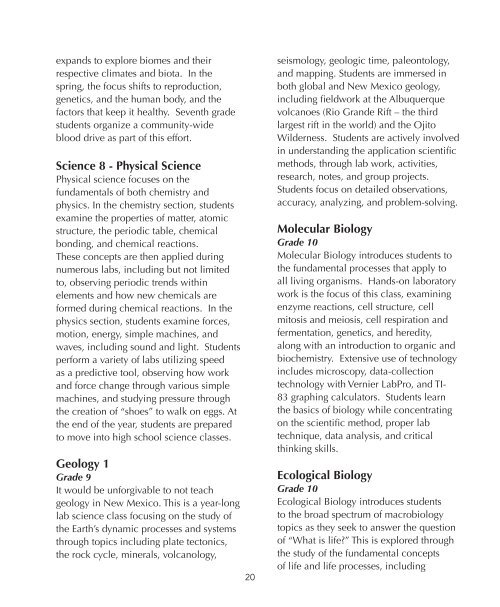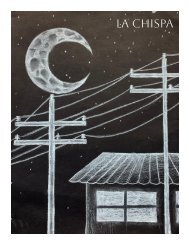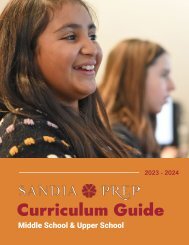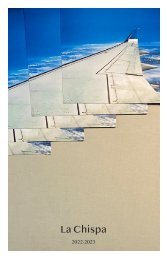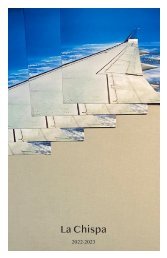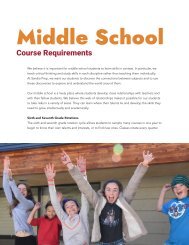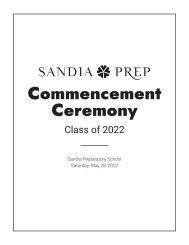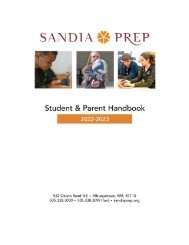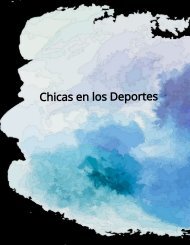Sandia Prep Curriculum Guide 2018 - 2019
Middle School and Upper School curriculum guide for the 2018 - 2019 school year
Middle School and Upper School curriculum guide for the 2018 - 2019 school year
You also want an ePaper? Increase the reach of your titles
YUMPU automatically turns print PDFs into web optimized ePapers that Google loves.
expands to explore biomes and their<br />
respective climates and biota. In the<br />
spring, the focus shifts to reproduction,<br />
genetics, and the human body, and the<br />
factors that keep it healthy. Seventh grade<br />
students organize a community-wide<br />
blood drive as part of this effort.<br />
Science 8 - Physical Science<br />
Physical science focuses on the<br />
fundamentals of both chemistry and<br />
physics. In the chemistry section, students<br />
examine the properties of matter, atomic<br />
structure, the periodic table, chemical<br />
bonding, and chemical reactions.<br />
These concepts are then applied during<br />
numerous labs, including but not limited<br />
to, observing periodic trends within<br />
elements and how new chemicals are<br />
formed during chemical reactions. In the<br />
physics section, students examine forces,<br />
motion, energy, simple machines, and<br />
waves, including sound and light. Students<br />
perform a variety of labs utilizing speed<br />
as a predictive tool, observing how work<br />
and force change through various simple<br />
machines, and studying pressure through<br />
the creation of “shoes” to walk on eggs. At<br />
the end of the year, students are prepared<br />
to move into high school science classes.<br />
Geology 1<br />
Grade 9<br />
It would be unforgivable to not teach<br />
geology in New Mexico. This is a year-long<br />
lab science class focusing on the study of<br />
the Earth’s dynamic processes and systems<br />
through topics including plate tectonics,<br />
the rock cycle, minerals, volcanology,<br />
20<br />
seismology, geologic time, paleontology,<br />
and mapping. Students are immersed in<br />
both global and New Mexico geology,<br />
including fieldwork at the Albuquerque<br />
volcanoes (Rio Grande Rift – the third<br />
largest rift in the world) and the Ojito<br />
Wilderness. Students are actively involved<br />
in understanding the application scientific<br />
methods, through lab work, activities,<br />
research, notes, and group projects.<br />
Students focus on detailed observations,<br />
accuracy, analyzing, and problem-solving.<br />
Molecular Biology<br />
Grade 10<br />
Molecular Biology introduces students to<br />
the fundamental processes that apply to<br />
all living organisms. Hands-on laboratory<br />
work is the focus of this class, examining<br />
enzyme reactions, cell structure, cell<br />
mitosis and meiosis, cell respiration and<br />
fermentation, genetics, and heredity,<br />
along with an introduction to organic and<br />
biochemistry. Extensive use of technology<br />
includes microscopy, data-collection<br />
technology with Vernier LabPro, and TI-<br />
83 graphing calculators. Students learn<br />
the basics of biology while concentrating<br />
on the scientific method, proper lab<br />
technique, data analysis, and critical<br />
thinking skills.<br />
Ecological Biology<br />
Grade 10<br />
Ecological Biology introduces students<br />
to the broad spectrum of macrobiology<br />
topics as they seek to answer the question<br />
of “What is life?” This is explored through<br />
the study of the fundamental concepts<br />
of life and life processes, including


